p.189
p.195
p.201
p.207
p.213
p.219
p.225
p.231
p.239
Mechanical Properties of Cast Shape Memory Alloy for Brain Spatula
Abstract:
In order to develop a brain spatula or a brain retractor made of a shape memory alloy (SMA), the bending characteristics of the brain spatula of TiNi SMA made by the precision casting were discussed based on the tensile deformation properties of the existing copper and the TiNi rolled-SMA. The fatigue properties of both materials were also investigated by the plane-bending fatigue test. The results obtained can be summarized as follows. (1) The modulus of elasticity and the yield stress for the cast and rolled SMAs are lower than those for the copper. Therefore, the conventional rolled-SMA spatula and the new cast-SMA spatula can be bent easily compared to the existing copper-brain spatula. (2) With respect to the alternating- and pulsating-plane bending fatigue, the fatigue life of both the copper and the SMAs in the region of low-cycle fatigue is expressed by a power function of the maximum bending strain. The fatigue life of the conventional rolled SMA and the new cast SMA is longer than that of the existing copper. The fatigue life of the new cast and rolled SMAs in the pulsating-plane bending is longer than that in the alternating-plane bending. (3) The fatigue life of the rolled-SMA and the cast SMA for alternating- and pulsating-plane bendings can be expressed by the unified relationship with a power function of the dissipated work.
Info:
Periodical:
Pages:
213-218
Citation:
Online since:
February 2011
Authors:
Price:
Сopyright:
© 2011 Trans Tech Publications Ltd. All Rights Reserved
Share:
Citation:


